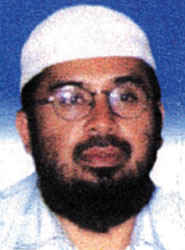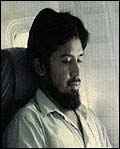|
Hambali What's the major difference between Osama bin Laden and Asian terror superstar Hambali? Hambali likes to think big.
What's the major difference between Osama bin Laden and Asian terror superstar Hambali? Hambali likes to think big.
The most dangerous man you've never heard of, the chip on Hambali's shoulder makes bin Laden look like Jimmy Carter. Before his capture in August 2003, he was notably absent from the FBI's list of most wanted terrorists, by virtue of keeping his operations pretty much out of the United States... Well, OK, if you don't count September 11. Aside from that pesky 9/11 connection, the omission was particularly glaring in light of Hambali's James Bond supervillain-sized aspirations the violent overthrow of all the nations of Southeast Asia, which would then be unified under a single militant Islamic government, creating a global superpower whose army and arsenal would rival the United States. The exact relationship between al Qaeda and Hambali's terrorist organization, Jemaah Islamiah (JI), has eluded Western intelligence agencies so far, at least as far as they're willing to tell us, the public. We know the two are connected, but it's not clear whether Hambali was a bin Laden lieutenant or a peer. Whoever was calling the shots, the two groups worked well together before and since Hambali's capture. Hambali is an enigmatic figure; there is little biographical detail to be had. His real name is Riduan Ismuddin. He was born in Java, Indonesia, a reasonably wealthy regional agricultural center. As a teenager, Hambali got involved with JI, a conglomerate of various Islamic fundamentalist groups which co-existed somewhat uneasily with Indonesia's military regime until a crackdown during the mid-1980s. Like many disaffected Muslim fundamentalists at the time, Hambali traveled to Afghanistan to help fight the Soviet invasion. The mujahideen training camps were a fertile incubator for extremists, and Hambali took to the cause like a fish to water. By his own account, he fought the Soviets and met with Osama bin Laden during his three-year tour as a mujahideen. By the time Hambali returned to Malaysia at the beginning of the 1990s, he had been transformed from a fundamentalist into a militant extremist. He again connected with Jemaah Islamiah, teaming with its theological figurehead, a cleric and activist named Abu Bakar Bashir. Hambali was one of several charismatic leaders in the region with strong ties to Osama bin Laden and the incipient al Qaeda organization. Money flowed from bin Laden's coffers to fund the start-up of several terror groups in Southeast Asia, most infamously the Abu Sayyaf group in the Philippines. Unlike Abu Sayyaf, Jemaah Islamiah had a fairly lengthy history, but Hambali's arrival took the group in a new direction. Bashir had always been a fundamentalist, but he wasn't especially militant. While insinuating himself with Bashir, Hambali labored on a shoestring to provide for his family, until the mid-1990s, when a series of Arab visitors brought a sudden influx of cash, according to Time Magazine Asia. It didn't take long for Hambali to start putting his newfound wealth and influence to work. Hambali founded a shell company called Konsojaya in June 1994. Like many terrorist front operations, Konsojaya claimed to be an "import-export" company, with only a vague product mix. Its primary export was terrorism, and the company is thought to have provided material assistance to a number of ongoing regional plots. An al Qaeda Ally Hambali's links to al Qaeda are clearly illustrated by one of the first plots that Konsojaya funded. One man serving on the company's board of directors was named Wali Khan Amin Shah, a figure with a critical link to al Qaeda's operations in the Philippines and the plot which would eventually become the September 11 attack.
Hambali's links to al Qaeda are clearly illustrated by one of the first plots that Konsojaya funded. One man serving on the company's board of directors was named Wali Khan Amin Shah, a figure with a critical link to al Qaeda's operations in the Philippines and the plot which would eventually become the September 11 attack.
A veteran mujahideen, Wali Khan went to the Philippines in late 1994, where he joined a terrorist cell which nominally operated under the umbrella of the local Muslim separatist group, Abu Sayyaf. The launch of Abu Sayyaf was funded and largely directed by Osama bin Laden. The founder of the group was a mujahideen with close ties to bin Laden, and the money to get things rolling allegedly came to the Philippines via bin Laden's brother-in-law, Mohammed Jamal Khalifa, who set up his own "import-export" company (known as the Benevolence International Corp.) and several Islamic charities, from which funds were diverted for terrorist attacks. Under the close supervision of Khalifa, a team of expert Arab terrorists was sent to Manilla in 1994, under direct orders from Osama bin Laden to craft attacks on U.S. interests. Among the cell's members were uberterrorist Ramzi Yousef, al Qaeda's strategic mastermind Khalid Shaikh Mohammed and Wali Khan. Konsojaya provided funding and operational assistance to the Manila cell, according to Philippines investigators, various intelligence agencies and testimony presented at the U.S. trial of Wali Khan. The Manilla cell was charged with several tasks, among them the assassinations of President Bill Clinton and Pope John Paul II. The first was nixed by Yousef as too difficult; the second was prevented only by an accidental fire at the plotters' apartment, which exposed the cell to local police in January 1995. When police swarmed over the apartment, they discovered documents, supplies and computer files which outlined a massive terrorist attack on U.S. interests. The "Bojinka" plot would have detonated bombs on 11 U.S.-bound airliners virtually simultaneously, and it included a second phase in which a suicide pilot would hijack a commercial jet and crash it into the Pentagon. Sound familiar? Philippines authorities nabbed a couple of foot-soldiers, but let Yousef and Khalid Shaikh escape the country. Wali Khan was actually arrested by Philippines police but escaped in short order. He was arrested in Malaysia in December 1995, and extradited to the U.S., where he was sentenced to life in prison for the Bojinka plot, alongside Ramzi Yousef and another operative. Hambali's sponsorship somehow escaped notice at the time the plot was exposed, but the close call was enough to slow the JI leader's ambitions. He began consolidating his power base, focusing on preaching (his religious authority is largely self-appointed), fund-raising and recruiting. The Unwanted 9/11 PlotterHambali went completely underground in late 2000, when his now-consolidated organization began a series of dozens of church bombings across Indonesia, killing at least a score of people and injuring scores more. According to interviews conducted by Time Asia, Hambali took a "hands-on" approach to the project, arriving "with detailed plans, plenty of cash and two of his own bombmakers" and disappearing before the bombing spree began.While Hambali went underground, the spiritual leader of Jemaah Islamiah, Abu Bakr Bashir, remained in plain sight, preaching jihad and teaching at an Islamic school in Indonesia. Despite widespread accusations of his involvement in JI, Bashir steadfastly denied any connection to terror, and the Indonesian government declined to arrest him, citing "lack of evidence" but actually motivated by "fear of reprisals." After JI bombed a Bali nightclub in late 2002, killing nearly 200 people on the anniversary of al Qaeda's attack on the U.S.S. Cole, international pressure reached a fever pitch and the Indonesia authorities finally detained Bashir. In addition to the Bojinka link to 9/11, Hambali is known to have more direct links to the disastrous terrorist attack on America, which leads one to wonder why no one in the U.S. ever talks about him. In January 2000, a meeting between Hambali and two of the 9/11 hijackers was caught on videotape. Hambali is also considered to be a close associate of Khalid Shaikh Mohammed, the al Qaeda planner who masterminded the Sept. 11 attack and is believed to have planned JI's Bali nightclub bombing. Hambali also provided money and travel documents for alleged "20th hijacker" Zacarias Moussaoui. The exact nature of the relationship between al Qaeda and Hambali is unclear. Several media reports identify him either as being in charge of al Qaeda's operations in Southeast Asia. Others seem to indicate that JI is simply affiliated with Qaeda. Regardless of how the hierarchy is defined, Hambali's agenda differs from al Qaeda's formal mission statement, which is generally focused on expelling U.S. forces from the Persian Gulf by means of terrorist attacks on U.S. interests. Wrap Your Brain Around ThisIf you think 9/11 seemed like a "failure of imagination" on the part of U.S. intelligence agencies and policy makers, then the failure to focus on Hambali can only be due to an apocalyptic lack of imagination Although the odds are pretty daunting, Hambali's ambitious plan would, if successful, create a full-fledged superpower under the control of extremists just like bin Laden. According to the CIA world factbook, Hambali's super-state would have a population of nearly 420 million people (compared to the U.S. population of 280 million). The conscript base of men fit for military service would number well over 75 million, significantly higher than the U.S. The super-state would have a chokehold on shipping lanes in the South China Sea providing access from Asia proper to the Indian Ocean, enabling it to exert significant control over sea trade and airspace flowing to India, Africa and Australia. In addition to the traditional weapons of terrorism, Hambali's JI is armed with several logistical and political weapons. Malaysia and Indonesia are both already Islamic governments with a bad history of enforcement against terrorists in general and JI in particular. Both governments also opposed the U.S. invasion of Afghanistan and are generally anti-U.S. on both cultural and policy levels. Indonesia flatly denies the existence of any al Qaeda presence within its borders, which is blatantly ridiculous on the face of it. Even the U.S. can't make that claim. Additionally, the cell structure and membership of JI is still virtually unknown, in part due to the lack of cooperating governments in the region, as well as the lack of clarity about the depth and breadth of alliances among the various regional terrorist factions. And it's not just the active terrorist operatives who are a problem. Hambali is much more effective than bin Laden at playing the religious card. He has a receptive audience within the general population of Islamic fundamentalists who could be provoked to militancy by circumstance, rhetorical skill or in reaction to any one of dozens of U.S. foreign policy decisions (such as a war on Iraq, just to state the glaringly obvious). In addition to the documented ties between Qaeda and JI, bin Laden is known to be generally supportive of the plan to create a pan-Islamic state through violent revolution and al Qaeda has directed significant resources to the job. Right up until Hambali's arrest in Thailand in August 2003, JI has been stockpiling tons of ammonium nitrate, the volatile fertilizer used by Timothy McVeigh to destroy the Murrah Federal Building in Oklahoma City. Much of that material is still unaccounted for. As 2004 comes to a close, the U.S. appears to have largely given up on catching bin Laden and his top lieutenant Ayman Al-Zawahiri, who have been enthusiastically inflaming Muslims in Southeast Asia and elsewhere over the ongoing and barely successful occupation of Iraq, with the hopes of escalating it into a regional conflict, which would play into the movement and ideology successfully spread by Hambali, even though the man himself has been taken out of commission. If the "movement" catches on, the 9/11 "failure of imagination" may seem awfully small by comparison. Consider the consequences of a third global superpower, with Osama bin Laden as president. And then ask yourself why you never heard of that guy, Hambali. |